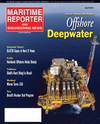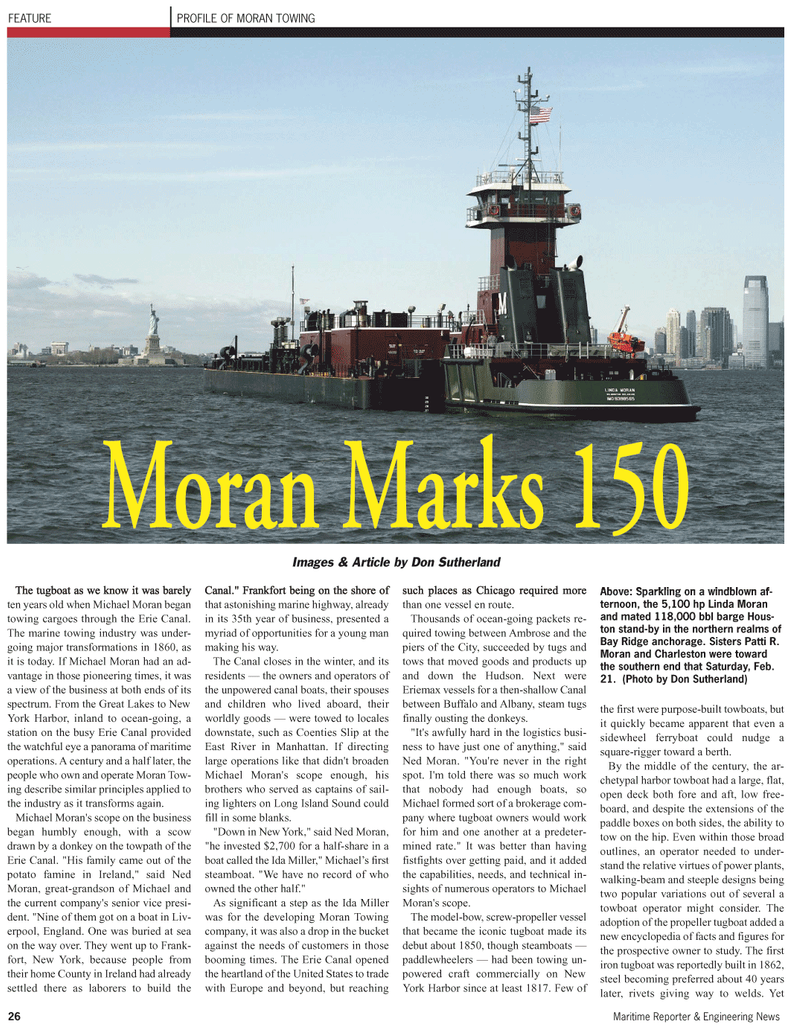
Page 26: of Maritime Reporter Magazine (April 2, 2010)
Read this page in Pdf, Flash or Html5 edition of April 2, 2010 Maritime Reporter Magazine
The tugboat as we know it was barely ten years old when Michael Moran began towing cargoes through the Erie Canal.
The marine towing industry was under- going major transformations in 1860, as it is today. If Michael Moran had an ad- vantage in those pioneering times, it was a view of the business at both ends of its spectrum. From the Great Lakes to New
York Harbor, inland to ocean-going, a station on the busy Erie Canal provided the watchful eye a panorama of maritime operations. A century and a half later, the people who own and operate Moran Tow- ing describe similar principles applied to the industry as it transforms again.
Michael Moran's scope on the business began humbly enough, with a scow drawn by a donkey on the towpath of the
Erie Canal. "His family came out of the potato famine in Ireland," said Ned
Moran, great-grandson of Michael and the current company's senior vice presi- dent. "Nine of them got on a boat in Liv- erpool, England. One was buried at sea on the way over. They went up to Frank- fort, New York, because people from their home County in Ireland had already settled there as laborers to build the
Canal." Frankfort being on the shore of that astonishing marine highway, already in its 35th year of business, presented a myriad of opportunities for a young man making his way.
The Canal closes in the winter, and its residents — the owners and operators of the unpowered canal boats, their spouses and children who lived aboard, their worldly goods — were towed to locales downstate, such as Coenties Slip at the
East River in Manhattan. If directing large operations like that didn't broaden
Michael Moran's scope enough, his brothers who served as captains of sail- ing lighters on Long Island Sound could fill in some blanks. "Down in New York," said Ned Moran, "he invested $2,700 for a half-share in a boat called the Ida Miller," Michael’s first steamboat. "We have no record of who owned the other half."
As significant a step as the Ida Miller was for the developing Moran Towing company, it was also a drop in the bucket against the needs of customers in those booming times. The Erie Canal opened the heartland of the United States to trade with Europe and beyond, but reaching such places as Chicago required more than one vessel en route.
Thousands of ocean-going packets re- quired towing between Ambrose and the piers of the City, succeeded by tugs and tows that moved goods and products up and down the Hudson. Next were
Eriemax vessels for a then-shallow Canal between Buffalo and Albany, steam tugs finally ousting the donkeys. "It's awfully hard in the logistics busi- ness to have just one of anything," said
Ned Moran. "You're never in the right spot. I'm told there was so much work that nobody had enough boats, so
Michael formed sort of a brokerage com- pany where tugboat owners would work for him and one another at a predeter- mined rate." It was better than having fistfights over getting paid, and it added the capabilities, needs, and technical in- sights of numerous operators to Michael
Moran's scope.
The model-bow, screw-propeller vessel that became the iconic tugboat made its debut about 1850, though steamboats — paddlewheelers — had been towing un- powered craft commercially on New
York Harbor since at least 1817. Few of the first were purpose-built towboats, but it quickly became apparent that even a sidewheel ferryboat could nudge a square-rigger toward a berth.
By the middle of the century, the ar- chetypal harbor towboat had a large, flat, open deck both fore and aft, low free- board, and despite the extensions of the paddle boxes on both sides, the ability to tow on the hip. Even within those broad outlines, an operator needed to under- stand the relative virtues of power plants, walking-beam and steeple designs being two popular variations out of several a towboat operator might consider. The adoption of the propeller tugboat added a new encyclopedia of facts and figures for the prospective owner to study. The first iron tugboat was reportedly built in 1862, steel becoming preferred about 40 years later, rivets giving way to welds. Yet 26 Maritime Reporter & Engineering News
FEATURE PROFILE OF MORAN TOWING
Moran Marks 150
Above: Sparkling on a windblown af- ternoon, the 5,100 hp Linda Moran and mated 118,000 bbl barge Hous- ton stand-by in the northern realms of
Bay Ridge anchorage. Sisters Patti R.
Moran and Charleston were toward the southern end that Saturday, Feb. 21. (Photo by Don Sutherland)
Images & Article by Don Sutherland

 25
25

 27
27
